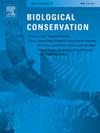The effect of artificial light at night on sea turtle hatchling early dispersal: A systematic review of methods, impacts and findings
IF 4.9
1区 环境科学与生态学
Q1 BIODIVERSITY CONSERVATION
引用次数: 0
Abstract
Artificial light at night (ALAN) is a rapidly expanding pollutant, raising concerns about its impact on species that rely on natural light cues for critical behaviours, such as for sea turtle early dispersal. After emergence, sea turtle hatchlings orient themselves using natural light cues to quickly crawl to the ocean (sea-finding) and swim offshore. Numerous studies have shown that artificial light disrupts their capacity to orient during their early dispersal with varying consequences, although variability exists in the methodologies used and the results. Here, we systematically reviewed the literature (74 publications) to summarise the methods and findings on the impacts of ALAN on sea turtle hatchlings during early dispersal. The review highlights key findings on how hatchling orientation during early dispersal is disrupted by different light types, light intensity, and distance to the light source. We review the visual capabilities of sea turtles and relate this ability to their behavioural attraction to different light types. Additionally, we discuss the availability of empirical evidence for energetic, behavioural, and physiological costs and consequences of disrupted orientation, along with management strategies that have been proposed to reduce the risk posed by ALAN. We conclude that more studies measuring the consequences of disrupted orientation are required to determine the long-term impacts of artificial lighting for turtle populations. Further, we suggest that research move towards identifying light intensity thresholds for artificial lights of different spectra and develop light exclusion zones to assist with management and promote best practice for lighting in coastal areas to protect these endangered species.

夜间人造光对海龟孵化早期扩散的影响:方法、影响和结果的系统综述
夜间人造光(ALAN)是一种迅速扩大的污染物,它对依赖自然光线索进行关键行为的物种(如海龟的早期扩散)的影响引起了人们的关注。在出现后,海龟幼崽利用自然光线索定位自己,迅速爬向海洋(寻海)并游向海岸。许多研究表明,人造光破坏了它们在早期扩散过程中的定向能力,造成了不同的后果,尽管所使用的方法和结果存在差异。在此,我们系统地回顾了74篇文献,总结了ALAN对海龟早期扩散过程中孵化的影响的方法和研究结果。这篇综述强调了在早期扩散过程中孵化方向如何受到不同光类型、光强度和光源距离的影响的关键发现。我们回顾了海龟的视觉能力,并将这种能力与它们对不同光线类型的行为吸引力联系起来。此外,我们还讨论了定向紊乱的能量、行为和生理成本和后果的经验证据的可用性,以及为降低定向紊乱带来的风险而提出的管理策略。我们的结论是,需要更多的研究来衡量定向中断的后果,以确定人工照明对海龟种群的长期影响。此外,我们建议进一步研究确定不同光谱人工光源的光强阈值,并制定禁光区,以协助管理和推广沿海地区的最佳照明实践,以保护这些濒危物种。
本文章由计算机程序翻译,如有差异,请以英文原文为准。
求助全文
约1分钟内获得全文
求助全文
来源期刊

Biological Conservation
环境科学-环境科学
CiteScore
10.20
自引率
3.40%
发文量
295
审稿时长
61 days
期刊介绍:
Biological Conservation is an international leading journal in the discipline of conservation biology. The journal publishes articles spanning a diverse range of fields that contribute to the biological, sociological, and economic dimensions of conservation and natural resource management. The primary aim of Biological Conservation is the publication of high-quality papers that advance the science and practice of conservation, or which demonstrate the application of conservation principles for natural resource management and policy. Therefore it will be of interest to a broad international readership.
 求助内容:
求助内容: 应助结果提醒方式:
应助结果提醒方式:


